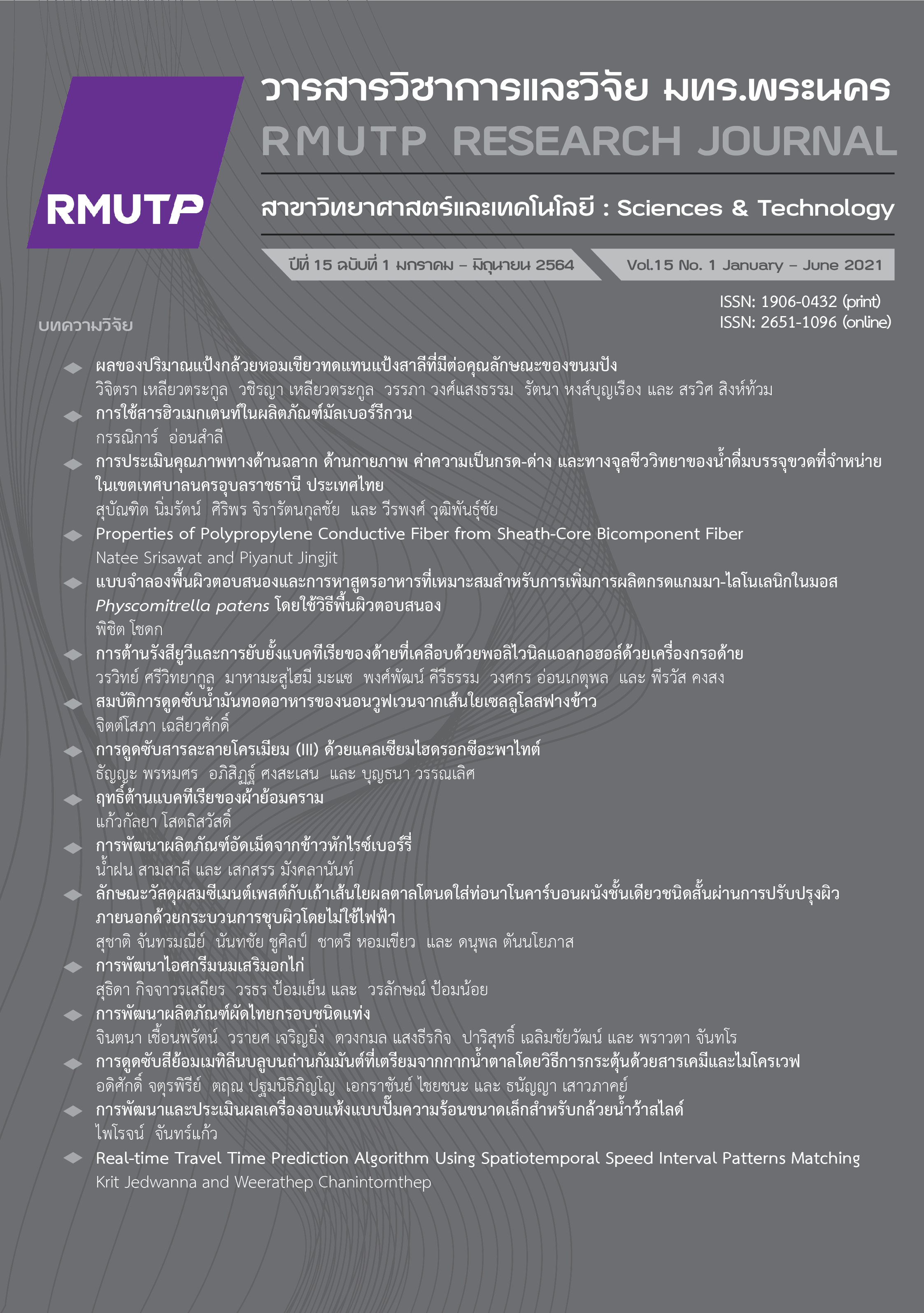Antibacterial Activity of Indigo Dyed Fabrics
Main Article Content
Abstract
The objective of this research was to study the antibacterial activity of 16 samples of indigo dyed fabrics that are produced and sold in Sakon Nakhon Province. Effect of moisture and pH of indigo dyed fabrics on bacterial growth were also determined. The result of the study shows inhibition of S. aureus TISTR 746 and E. coli TISTR 073 by agar diffusion plate test, all samples could inhibit S. aureus TISTR 746 (accounted as 100%), and only 9 samples could inhibit E. coli TISTR 073 (accounted as 56.25%). Whereas, the study of antibacterial activity by AATCC test method 100-2004 at 24 hours was found that the natural indigo dyed fabrics code A3-1 could inhibit both bacterial strains in the highest level. The result also shows the effect of moisture and pH of indigo dyed fabrics on bacterial growth, it was found that the increased humidity levels of indigo dyed fabrics have effect on the reduction of the inhibition efficacy of both strains. While indigo dyed fabric with pH 3.0 was found to inhibit most of the growth of both strains. In addition, images obtained using a scanning electron microscope (SEM) could clearly confirm the property of indigo dyed fabric on inhibition of S. aureus TISTR 746 and E. coli TISTR 073.
Article Details
References
M. Khati, F. Ahmed, I. Shaikh, D. N. Phan, K. Kham, Z. Khati, H. Lee and I. S. Kim, “Dyeing and Characterization of Regenerated cellulose nanofibers with vat dyes,” Carbohydrate Polymers, vol. 174, pp. 443-449, Oct. 2017.
D. Chathiphot, “Indigo Dye Fabric: Commodization of Culture in the Tide of Globalization,” Journal of Thai Studies, vol. 10, no. 2, pp. 87-153, Aug. 2014-Jan. 2015.
A. Saithong, T. Wanruengrong and U. Sunaprom, “The Development of Indigo - Dyed Cloths’Pattern for the New Generation People”, Sakon Nakhon Rajabhat University Journal, vol. 7, no. 13, pp. 11-20, Jan. – Jun. 2015.
O. Pupatana, “Intensity of Natural Indigo Dyed Cotton Fabrics with UV Protection,” RMUTI JOURNAL Science and Technology, vol. 11, no. 2, pp. 129-141, May – Aug. 2018.
P. Chuysoodsakulchai, A. Saithong and A. Phothikanith, “The Study of Underarm Bacterial Inhibition Properties of Indigo Dyed Textiles,” Sakon Nakhon Graduate Studies Journal, vol. 7, no. 29, pp. 57-66, Mar.- Apr. 2010.
J. Tapaopong, S. Suwanmanee and N. Luplertlop, “Evaluation of Pathogenic Microorganisms Contaminated in Derma-tology Outpatient Clinic During the Midst of Rainy Season,” Journal of Medicine and Health Sciences, vol. 22, no. 2, pp. 8-14, Aug. 2015.
S. Li, T. Zhu, J. Huang, Q. Guo, G. Chen and Y. Lai, “Durable Antibacterial and UV-Protective Ag/TiO2 @ Fabrics for Sustainable Biomedical Application,” International Journal of Nanomedicine, vol. 12, pp. 2593–2606, 2017.
G. Pook-In, K. Seansupa and S. Upakut, “Inhibition of Staphylococcus aureus by the Cotton Fabrics Treated with the Crude Finish Produced from Streptomyces sp. strain AC4,” Journal of Food Health and Bioenvironmental Science, vol. 12, no. 1, pp. 44-53, 2019.
S. Jayapriya and G. Bagyalakshmi, “Textile Antimicrobial Testing and Standards,” Journal of Textile and Fashion Techno-logy, vol. 4, no. 1, pp. 1-10, 2013.
H. Cui, X. Zhang, H. Zhou, C. Zhao and L. Lin, “Antimicrobial Activity and Mechanisms of Salvia sclarea Essential Oil,” Botanical Studies, vol. 56, pp. 16, 2015.
A.K. Tyagi and A. Malik, “Morphostructural Damage in Food-Spoiling Bacteria due to the Lemon Grass Oil and Its Vapour: SEM, TEM, and AFM Investigations,” Evidence-Based Complementary and Alternative Medicine, vol. 2012, pp. 1-12, 2012.
O. Sangwong, T. Pawong, P. Pudtumma and S. Arthan, “The Simple Natural Indigo fabric test kit by Column Chromato-graphy,” KKU Science Journal, vol. 47, no. 1, pp. 117-126, 2019.
N. Chanayath, S. Lhieochaiphant and S. Phutrakul, “Pigment Extraction Techniques from the Leaves of Indigofera tinctorial Linn. and Baphicacanthus cusia Brem. and Chemical Structure Analysis of Their Major Components,” Chiang Mai University Journal, vol. 1, no. 2, pp. 149-160, 2002.
N. A. Al-Dhabi, C. Balachandran, M. K. Raj, V. Duraipandiyan, C. Muthukumar, S. Ignacimuthu, I. A. Khan and V. S. Rajput “Antimicrobial, Antimycobacterial and Antibiofilm Properties of Couroupita guianensis Aubl. Fruit Extract. In Biofilm Control and Antimicrobial Agent, S. M. A. Sayem, editor. Oakville, Apple Academic Press, 2014, pp. 223-238.
Y.-R. Chiang, A. Li, Y.-L. Leu, J.-Y. Fang and Y.-K. Lin, “An In Vitro Study of the Antimicrobial Effects of Indigo Naturalis Prepared from Strobilanthes formosanus Moore,” Molecules, vol. 18, no. 11, pp. 14381–14396, 2013.
K. P. Renukadevi and S. S. Sultana, “Detection of Antibacterial, Antioxidant and Cytotoxicity Effect of Indigofera tinctorial on Lung Cancer Cell Line NCI-h69,” International Journal of Pharma-cology, vol. 7, no. 3, pp. 356-362, 2011.
G. J. Tortora, B. R. Funke and C. L. Case, Microbiology: An Introduction, 8th ed. San Francisco: Pearson Benjamin Cummings, 2004.
L. M. Wheelis, Principle of Modern Microbiology. Massachusetts: Jones and Bartlett Publishers, 2008.
G. Sharma, S. Sharma, P. Sharma, D. Chandola, S. Dang, S. Gupta and R. Gabrani, “Escherichia coli Biofilm: Development and Therapeutic Strategies,” Journal of Applied Microbiology, vol. 121, pp. 309-319, 2016.
X.-H. Li and J.-H. Lee, “Antibiofilm Agents: A New Perspective for Antimicrobial Strategy,” Journal of Microbiology, vol. 55, pp. 753–766, 2017.

